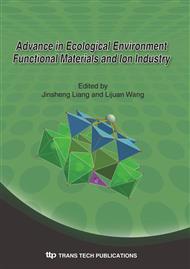p.75
p.81
p.87
p.93
p.99
p.105
p.111
p.117
p.121
Inactivation of Escherichia Coli on Titanium Dioxide Photocatalysis Nanoparticles
Abstract:
The effects of P25 TiO2 made by DEGUSSA and one kind nano-titanium dioxide made by a certain company in China (Expressed by Tc) on Escherichia coli were tested by the minimal inhibitory concentration (MIC) method, and the status dispersed of two kinds nano-TiO2 and the micro-phenomenon of the effect on Escherichia coli were observed by scanning electron microscope (SEM). The hydroxyl radical (•OH) signal intensity in liquid produced by nano-TiO2 was tested by electron spinning resonance (ESR). It was found that the MIC of the P25 and Tc were 500 mg/L and 5 g/L, respectively. The cells of E. coli which were attached by the nano-TiO2 particles were damaged strongly, and the membrane was dissolved and dispersed under SEM. The intensity of •OH signal produced by P25 was stronger than that of Tc tested by ESR. The size of E. coli was 0.4~0.7×1~3 µm, and the average diameter of nano-TiO2 was 20 nm. When the nano-TiO2 particles touch the E. coli, it would stick to the surface of the cell wall and destroy the cell membrane, lead to the canker of cell membrane and the outflow of cytoplasm. The difference of the MIC between the two kinds of nano-powders may be due to their dispersion degree and the particle diameter which influence the •OH production.
Info:
Periodical:
Pages:
99-104
Citation:
Online since:
January 2010
Authors:
Keywords:
Price:
Сopyright:
© 2010 Trans Tech Publications Ltd. All Rights Reserved
Share:
Citation:


